⇡#Упаковка и комплектация
Коробку Liquid Freezer II 360 RGB в Arctic решили сделать более яркой и привлекательной, что вполне логично — с учётом новых вентиляторов с подсветкой
Как раз они-то и перетягивают на себя всё внимание на изображении с лицевой стороны коробки. Там же указаны название системы, наличие термопасты MX-5 в комплекте и поддержка систем подсветок материнских плат всех основных производителей
На обратной стороне коробки приведено краткое назначение системы и QR-код, ведущий на инструкцию по установке.

На основании можно найти разного рода логистическую информацию и сведения о стране производства – это Китай.
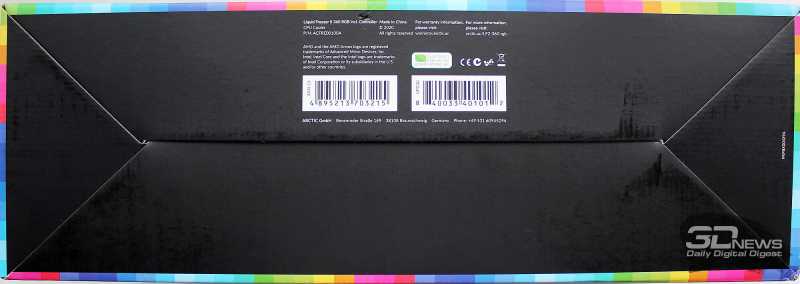
Не пустуют и торцы коробки, где приведены QR-код технической поддержки, технические характеристики и перечень поддерживаемых платформ.
 |
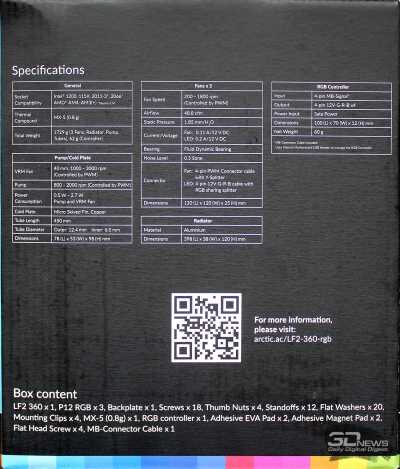 |
Внутри коробки радиатор с вентиляторами отделён от других комплектующих картонной вкладкой и облачён в полиэтиленовый пакет, а помпа с водоблоком вставлены ещё в одну небольшую коробку с вырезом.
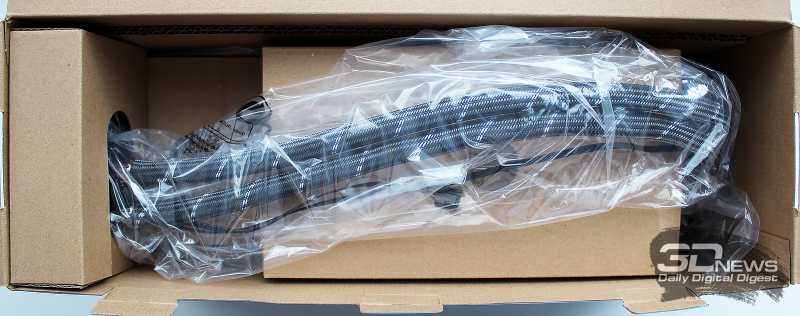
Комплектующие размещены в отдельной большой коробке, внутри которой запечатаны крепления и плоская коробочка с контроллером подсветки.
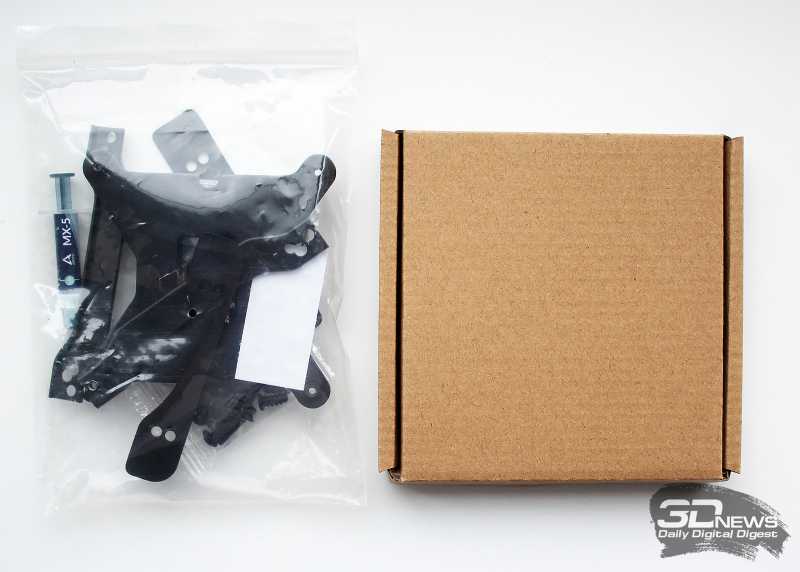
Рекомендованная стоимость нашей версии СЖО составляет 140 евро, а версия без RGB-контроллера стоит на 10 евро дешевле. В России Arctic Liquid Freezer II 360 RGB можно приобрести за 10 190 рублей. Жаль только, что официальная шестилетняя гарантия Arctic в нашей стране превращается в двухлетнюю.
⇡#Совместимость и установка
Как и другие СЖО Arctic серии Liquid Freezer II, новую Liquid Freezer II 360 RGB можно установить на процессоры AMD конструктивного исполнения Soсket AM4 и процессоры Intel конструктивных исполнений LGA115(х)/2011(v3)/2066/1200. Процесс установки также не претерпел никаких изменений. Кратко опишем последовательность действий на примере платы с LGA1200.
Перед установкой водоблока на процессор к его основанию винтами приворачиваются две стальные направляющие (для AMD и Intel нужно использовать разные пары направляющих).
Затем на обратную сторону материнской платы устанавливается усилительная пластина (backplate), в отверстия которой вворачиваются шпильки с резьбой. Отметим, что шпильки стоит вворачивать через изоляционные шайбы, которые нужно заблаговременно приклеить на плату.
При этом backplate не имеет клеевой основы, поэтому её придётся придерживать рукой во время установки или положить плату на стол (то есть в момент установки она будет вне корпуса системного блока). Это единственный неудобный момент в установке.
Ну вот и всё, остаётся только нанести термопасту и равномерно притянуть водоблок с помпой гайками с накатанной головкой. Затягивать их нужно до упора, усилие прижима высокое.
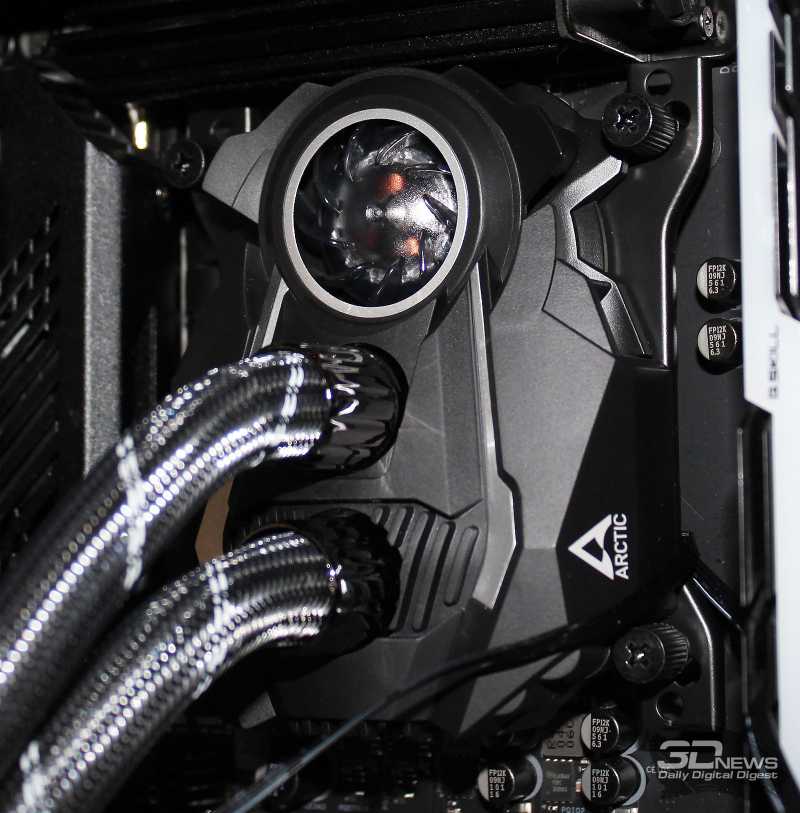
Что же касается радиатора с вентиляторами, то в нашем Thermaltake Core X71 мы разместили его на верхней стенке, направив воздушный поток за пределы корпуса.
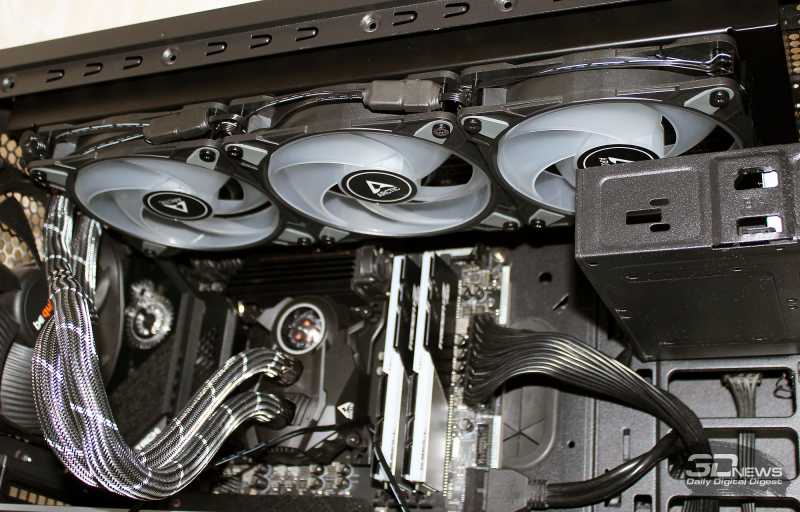
Подсветка вентиляторов очень красивая.
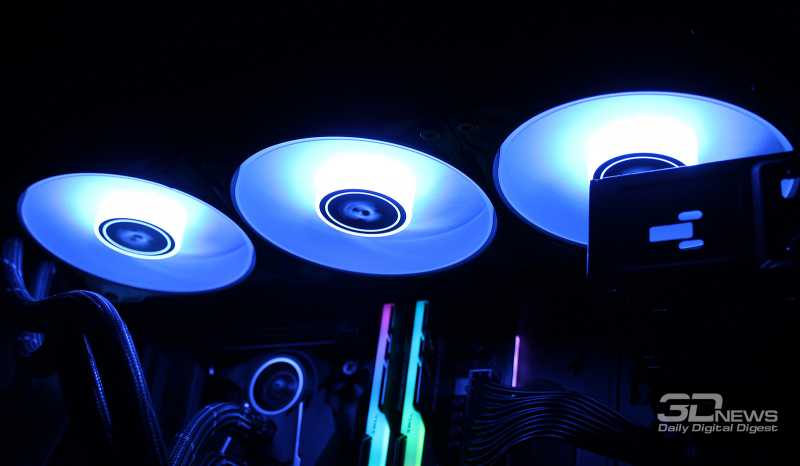
Пример установки
В нашем случае тестирование выполнялось на стенде с материнской платой и процессором, использующими разъём AM4, поэтому подготовка началась с прикручивания на основание водоблока специальных направляющих для сокетов AMD.
Вторым шагом удобно закрепить радиатор в имеющееся на корпусе ПК посадочное место, чтобы не держать его на весу при дальнейших операциях. Винты, которые идут в комплекте, подойдут только для тонкостенных корпусов. В случае с тестовым Cougar Conquer, имеющим прочную рамную конструкцию, их длины не хватило. Пришлось заменить на другие.
Крепление водоблока осуществляется к штатному бэкплейту материнской платы винтами, но предусматривает снятие заводских пластиковых защелок. Процесс несложный и требует лишь открутить четыре винта под «крестовую» отвертку вокруг сокета, после чего убрать две пластиковые детали и прикрутить взамен сам водоблок.
В случае с АМ4 получается только два возможных положения: вентилятором вверх с обдувом одного из радиаторов охлаждения цепей питания материнской платы, либо вентилятором вниз с дополнительным обдувом радиатора верхнего слота M.2 или части платы видеокарты.
Liquid Freezer II
The packaging for the Liquid Freezer II is rather quaint. It’s a fairly small box and the internals are just enough to keep the contents safe during transport. The box has all the pertinent information including diagrams of all the components and sizing on the side of the box. The included accessories are minimal with only the mounting hardware and a small packet of thermal paste, come on Arctic give us the tube of that good ole MX-4 and not just a taste. The installation manual is oddly absent, but it can be found using the QR code card and that’s going to take you to one of the most useful installation guides I’ve seen yet, even including animations showing you how the mounting brackets connect to the cold plate.
2 of 9
Part of what keeps the accessories so minimal is that this is how the Liquid Freezer II comes out of the box, 95% fully assembled. The 120mm Arctic P12 PWM fans with an RPM range of 200-1800 and a static pressure rating of 2.2mm H₂O come preinstalled to the radiator and wired through the tube sleeving for that ultra stealth look. The radiator bucks the trend of slim rads in favor of a fat 38mm thick aluminum radiator to make the absolute most of the cooling surface area, because of its size you’ll want to check clearance in your case if you’re installing over a motherboard. The inlet/outlet of the radiator being centered is a bit of a strange move, but it works.
2 of 9
The Pump/Cold Plate is one of the most interesting in a while. While we’ve seen designs from Cryorig with the A-series with a mounted fan, this one takes a unique approach and puts a blower-style fan in the casing to aid in cooling the VRMs. That’s the VRMs, not the memory, not the backplate of a graphics card, the VOLTAGE REGULATOR MODULE. The thing that a lot of people miss when they move from a stock, or even a tower-style cooler, is that they leave the area around the socket of a motherboard pretty much void of active airflow. While you might see a drop in temperature of your CPU, you can pretty much put money on it that your VRMs are running much warmer and that can impact your performance. This is especially true in cases with weak airflow or those open-air cases like the Thermaltake P3.
2 of 9
Conclusion
Best performing All In One Liquid Cooler I’ve ever tested pretty much sums up the experience I had with the Arctic Liquid Freezer II. The monochrome design means that it will likely fit into almost any build and can easily be spruced up to RGB fans of your choice if you wish. A thick rad and competent and quiet fans make for an alluring combination. The overall design of the pump/block/fan combo looks akin to the batmobile so that might be a turnoff for some. Intel mounting system is top-notch, but the AM4 mounting is going to likely have folks calling in backup to get it installed. I managed to install it by myself but I was really wishing I had another hand in the mix, maybe a retention clip on the screws would be enough to make it a much smoother experience. But with that single issue I have with the cooler and its unbeatable price and performance there’s no way I can let this one leave without the ‘Killer Value’ award. If you’re in the market for an AIO I suggest having the biggest one of these you can fit in your case on your list.
9.5
Wccftech Rating
The Liquid Freezer II changes what should be expected of an AIO. Flashy lights and LCD screens that do nothing but add cost need to reconsider their place in the market. The Liquid Freeze II conquers on all fronts but could use a better design for AM4 mounting.
Pros
- Comes 95% assembled
- Single header connection
- Quiet as a mouse operation
- Online installation guide is animated
- Fans can be replaced
Cons
AM4 mounting is cumbersome
Buy for $75.99 from Amazon
The links above are affiliate links. As an Amazon Associate, Wccftech.com may earn from qualifying purchases.
Внешний вид и особенности конструкции
На фоне массового сегмента систем жидкостного охлаждения 240-мм формата Arctic Cooling Liquid Freezer II 240 выделяется сразу несколькими моментами. В первую очередь очень аккуратным внешним видом, что достигается не только консервативно строгим и угловатым дизайном, но и скрытой укладкой проводов питания вентиляторов, которые проложены до водоблока под защитной оплёткой шлангов.
Алюминиевый радиатор получил увеличенную со стандартных 27 до 38 мм высоту рабочего тела и каркаса соответственно. Это накладывает свои ограничения по применимости в различных конфигурациях, так как не все производители корпусов оставляют соответствующий зазор между местом крепления материнских плат и верхними направляющими для крепления СЖО. В остальном он мало чем выделяется, представляя собой двенадцать плоских каналов с плотным заполнением пространства между ними гофролентой и защищенных прочной рамой.
Водоблок, представляющий собой распространенную схему компоновки в одном корпусе теплосъёмной пластины и помпы, выглядит вычурно и необычно. Причина тому — дополнительный маленький 40-мм вентилятор турбинного типа, который служит для обдува цепей питания в околосокетном пространстве.
Он однонаправленный, поэтому возлагать большие надежды не стоит. В современных материнских платах транзисторы фаз питания CPU и памяти, как правило, размещены слева и сверху от сокета процессора, поэтому обдуваться будет только одно из этих направлений. Но всё равно в условиях компактных корпусов или при разгоне процессора положительный эффект от дополнительного обдува будет не лишним.
Медная теплосъёмная пластина в основании имеет ровную поверхность, отполированную до полуглянцевого состояния.Наружная толщина — 3 мм, площадь ограничена квадратом 56 на 56 мм со срезанными углами.
Модель установленных 120-мм вентиляторов — Arctic P12 PWM. Они специально разработаны для применения на радиаторах СЖО и имеют оптимизированную крыльчатку, создающую во время вращения направленный завихрённый воздушный поток повышенного давления. Скорость вращения варьируется в диапазоне от 200 до 1800 оборотов в минуту посредством ШИМ-управления.
PRIME 95
Running Prime 95 is an absolute torture test anI ran it with SmallFFTs for 1 hour in a 22*C controlled ambient environment. Took note of the VRM thermals using HWinfo64 monitoring since the Liquid Freezer II offers up an actual VRM cooling fan. The stock cooler actually carries a benefit over a traditional AIO in this regard since the CPU temperature drives the fan to full speed and consequently increases airflow across the VRM area while the traditional AIO leaves you quite a bit wanting. Running the test with Boost disabled allowed for a very controlled method, but allowing Boost to do its thing showed where the VRMs can start to heat up when using a traditional AIO, we see here the Liquid Freezer II bringing the VRM thermals down more in line with what the downdraft Wraith Prism is delivering.
20
40
60
80
100
120
Wraith Prism
89
42
54
36
ML240P
86
41
64
41
Freezer II
78
35
54
31
20
40
60
80
100
120
Wraith Prism
95
49
54
37
ML240P
90
44
67
34
Freezer II
85
42
58
33
ARCTIC Liquid Freezer II 240 A-RGB Temperature Benchmarks
We tested the ARCTIC Liquid Freezer II 240 A-RGB on the Intel i9-12900K to test the cooler to the limits. The tests were conducted in the Thermaltake View 71t, which has 5 intake fans on the front whilst 3 fans are used for exhaust including the ARCTIC P12 PWM PST A-RGB Fans on top. We used the original MX-5 paste that came with the ARCTIC Liquid Freezer II 240 A-RGB in the box.
Test System
The latest Intel Core i9-12900K will be our friend during the testing, the rest of the specs are as below;
- MSI MEG Z690 Unify Motherboard
- Intel Core i9-12900K processor
- G.Skill Trident Z5 RGB Memory @ 5600MHz
- Nvidia GeForce RTX 3070 Ti Graphics card
- Windows 11 Pro
- Thermaltake View 71T
Testing Methodology
In BIOS, we set the i9-12900k voltage to 1.15V, the P-Cores to 4.9 GHz, and the E-Cores to 3.9 GHz. By forcing usage of roughly 140W, we enable comparison with basic heatsinks. We then ran the test in Aida64 for 5 minutes with the processor and memory boxes turned on. Finally, delta temperatures between the ambient temperature and the related test are considered for the ranking.
The benchmarks were taken twice: once with the PWM settings and again with the fans and pump set to full speed.
Benchmark Results

ARCTIC Liquid Freezer II 240 ARGB Benchmarks
In the graph above, we can see that the ARCTIC Liquid Freezer II 240 A-RGB outperforms a lot of other competitors. We put the coolers up against the Noctua air coolers and the Thermaltake Toughliquid 240 A-RGB.
The ARCTIC Liquid Freezer is seen crushing all of its competitors by maintaining a maximum temperature of 41.6 degrees under PWM settings, while other coolers were spotted crossing 45 degrees. The cooler managed to drop 2-3 degrees more at the Max settings, down to 38.3 degrees, which was far from amazing.
These tests demonstrated that the ARCTIC Liquid Freezer II 240 A-RGB is more than just a good cooler. The cooler is capable of outperforming any 240mm cooler on the market while competing with 360mm AIOs.
Тестирование
Конфигурация тестового стенда
| Тип комплектующих | Модель |
| Материнская плата | ASUS Strix X470-F Gaming (BIOS 5406 от 25.11.2019) |
| Процессор | AMD Ryzen 7 2700X |
| Система жидкостного охлаждения | Arctic Cooling Liquid Freezer II 240 |
| Термоинтерфейс | Arctic Cooling MX-4 |
| Оперативная память | 2 х ADATA Spectrix D41 3200 МГц 8 ГБ (AX4U320038G16-ST41) |
| Твердотельный накопитель | M.2 NVMe SSD ADATA XPG Gammix S5 512 ГБ |
| Видеоадаптер | EVGA GeForce GTX 970 SSC GAMING ACX 2.0+ 4 ГБ |
| Блок питания |
Thermaltake Toughpower PF1 ARGB 1050W |
| Корпус | Cougar Conquer |
| Операционная система | Microsoft Windows 10 Professional x64, версия 1903 со всеми обновлениями на 21.12.2019 |
Тесты системы охлаждения на стенде с указанной выше конфигурацией базируются на измерении температуры процессора по показаниям программы HWInfo 6.20 во время вычислительной нагрузки утилитами Prime95 29.8 build 6 и Furmark CPU Burner 0.1.0. В операционной системе предварительно включался профиль производительности, оптимизированный для процессоров AMD. Вентиляторы и помпа управлялись по PWM. Перед началом тестов в программе ASUS Fan Xpert 4 выполнялась их автоматическая настройка и включение профиля управления скоростью «Стандартный».
Оценка основания водоблока
Комплектная термопаста не нуждается в дополнительном представлении — это популярная MX-4, считающаяся одной из лучших в своём классе. Ровное основание медной пластины и металлические направляющие обеспечивают хороший прижим к теплораспределительной крышке процессора. Пятно контакта акцентировано в центре, что обеспечит хорошее отведение тепла от самой нагревающейся области.
Скорость и шум помпы и вентиляторов
Управление скоростью вентиляторов и помпы по отдельности не предусмотрено. Они подключены по цепочке к водоблоку, от которого выходит только один провод с четырёхконтактным штекером. Соответственно скорость, измеренная с помощью программы ASUS Fan Xpert 4, вероятнее всего отражает характеристики помпы, а алгоритм пропорционального изменения PWM-питания вентиляторов заложен производителем.
При этом шум от работы системы охлаждения можно охарактеризовать как низкий. Большую часть времени он находится в комфортной на слух зоне <30 дБА, лишь на максимуме производительности подбираясь к значению 34,3 дБА с расстояния 1 метр.
Стресс-тестирование
Для системы охлаждения заявлена поддержка процессоров с очень высоким TDP — до 300 Вт. По итогу тестирования в LinX и Prime95 можно сделать вывод, что эта цифра преувеличена, либо измерена по какой-то хитрой методике.
В утилите LinX 0.8.0K AMD Edition при потреблении процессора на уровне CPU Package Power (SMU)=220 Вт температура процессора колебалась возле отметки 83,6 ℃.
В Prime95 версии 29.8 build 6 при шестнадцати одновременных вычислительных потоках и CPU Package Power (SMU)=200 Вт температура ядер процессора не превысила отметки 84,1 ℃. Учитывая, что для тестового стенда, и AMD Ryzen 7 2700X в частности, троттлинг будет уже на 84,8 ℃, запас до этого порога составляет менее одного градуса, что можно считать погрешностью измерений. Сравнительные результаты с другими СЖО, протестированными ранее в той же конфигурации, приведены на диаграмме ниже.
При TDP менее 200 Вт СЖО закономерно показывает хорошую эффективность, но не выделяется на фоне 240-мм аналогов от других производителей, даже несмотря на радиатор большей высоты.
Значимого влияния дополнительного 40-мм вентилятора на температуру цепей питания материнской платы замечено не было, вероятнее всего, из-за хорошей продуваемости полуоткрытого корпуса тестового стенда. В корпусах малых габаритов наверняка результат будет совсем другой.
Should you get the ARCTIC Liquid Freezer II 240 A-RGB?
The ARCTIC Liquid Freezer II 240 A-RGB is a one-of-a-kind AIO, and for around 110 dollars, it’s almost free. We believe the ARCTIC Liquid Freezer II 240 A-RGB is a good value for money, given its cooling capabilities and looks.
When it comes to PC cooling, ARCTIC is a household brand, and the ARCTIC Liquid Freezer II 240 A-RGB is yet another example of that. The AIO’s cooling capabilities are outstanding, especially when compared to comparable AIO coolers in its pricing range. The AIO cooler has done admirably in our tests, and it is one of the finest coolers we’ve seen thus far. Along with cooling, many people admire the build quality and looks. While some may criticize the unique pump design, others will applaud the bold move.
The cooler comes in a bright, colorful package with the ARCTIC logo all on it. When we reach out to remove the cooler, we notice that it is somewhat heavier than comparable 240mm coolers. The odd pump design on the Liquid Freezer II 240 is the first thing we notice. A 40mm running fan is included in the actual pump for reasons such as greater cooling and less buzzing.
The pump has an odd form, but it’s not unusual, and it doesn’t interfere with RAM or PCIe clearance, nor is it difficult to install. Instead, because of its flatness, I found the pump head to be easier to work with than other cooler pump heads. The gleaming silver and black nylon tubing is also noticeable. The Nylon tubing feels strong, and the connection is sealed with chrome fittings on both sides.
Then we look at the radiator itself. The ARCTIC P12 PWM PST A-RGB Fans are already mounted in the 240mm radiator, which is made entirely of aluminum. The radiator is 277x120mm in length and width and is 38mm thick. The radiator is roughly 13mm thicker than the typical 240mm AIO, proving the extra weight. As previously stated, the fans are already installed with no cabling.
Yes, the fans do not require additional connections because they are powered by the Pump header through the tubing. The radiator’s cable management is spotless, and the fans are set up in a push-airflow arrangement. The two ARCTIC P12 PWM PST A-RGB Fans run quietly even at high speeds, and the RGB lighting is excellent owing to the frosted white blades. Overall, the radiator has a decent fin density of roughly 14 fins per inch, which aids in increased airflow and reduced fan RPMs.
We get a lot of accessories with the ARCTIC Liquid Freezer II 240 since the cooler supports a wide variety of Chipsets. Some may claim that the copper cold plate is too tiny for some sockets. The online tutorial makes installation go more smoothly. Although, for a better understanding right immediately, we would have appreciated an on-hand installation guide.
Overall, the ARCTIC Liquid Freezer II 240 A-RGB is a bargain at around 110 dollars. With superb RGB uniformity in the fan blades, the aesthetics are on target. Some others, though, would have chosen an RGB pump.
The radiator is strong and holds weight, making it a long-term buddy, albeit the broader size may make installation more difficult in some circumstances. Overall, we believe the ARCTIC Liquid Freezer II 240 A-RGB is one of the finest 240mm AIO coolers currently available for its pricing.
Thanks to ARCTIC for sending out their ARCTIC Liquid Freezer II 240 A-RGB for Review.

Installation
We’ll be installing the cooler on an Intel 115x socket chipset, so make sure you’re on the same page as us before proceeding, since installation for AMD and other sockets may change.
Before you begin, make sure your CPU is free of any previous thermal paste by wiping it off with cotton and rubbing alcohol. Install the radiator in the desired direction of airflow onto the top or front of your case using the 8x screws and flat washers provided.
With the radiator installed in place, now place the insulating washers on top of the motherboard, surrounding the backplate screw holes.
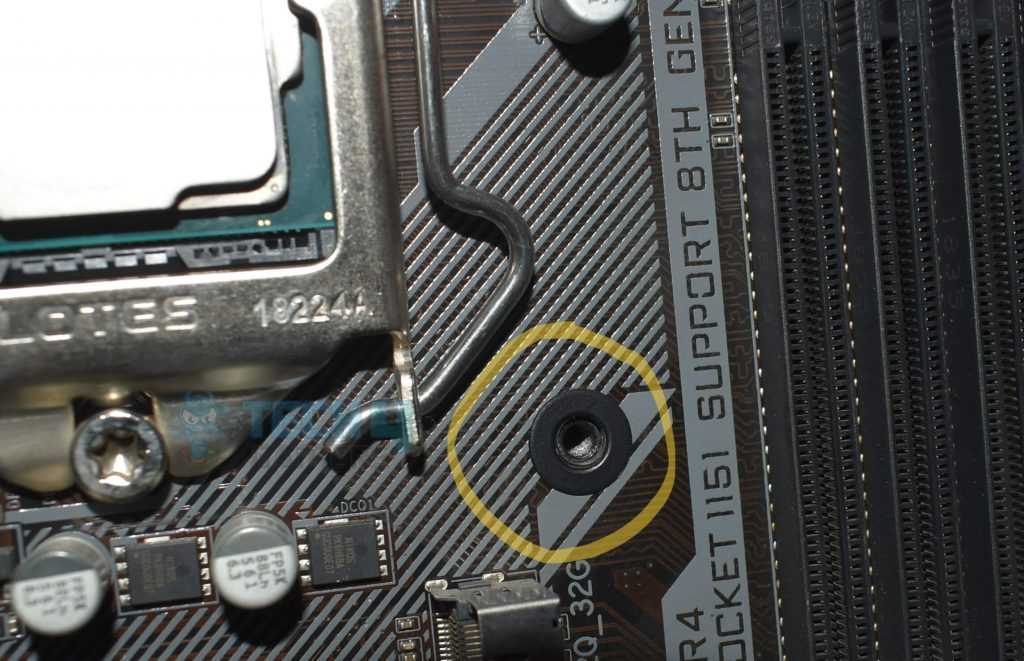
ARCTIC Liquid Freezer II 240 ARGB Installation
Place the backplate in the proper position, making that all holes are exactly aligned, once the insulating washers have adhered to the motherboard.
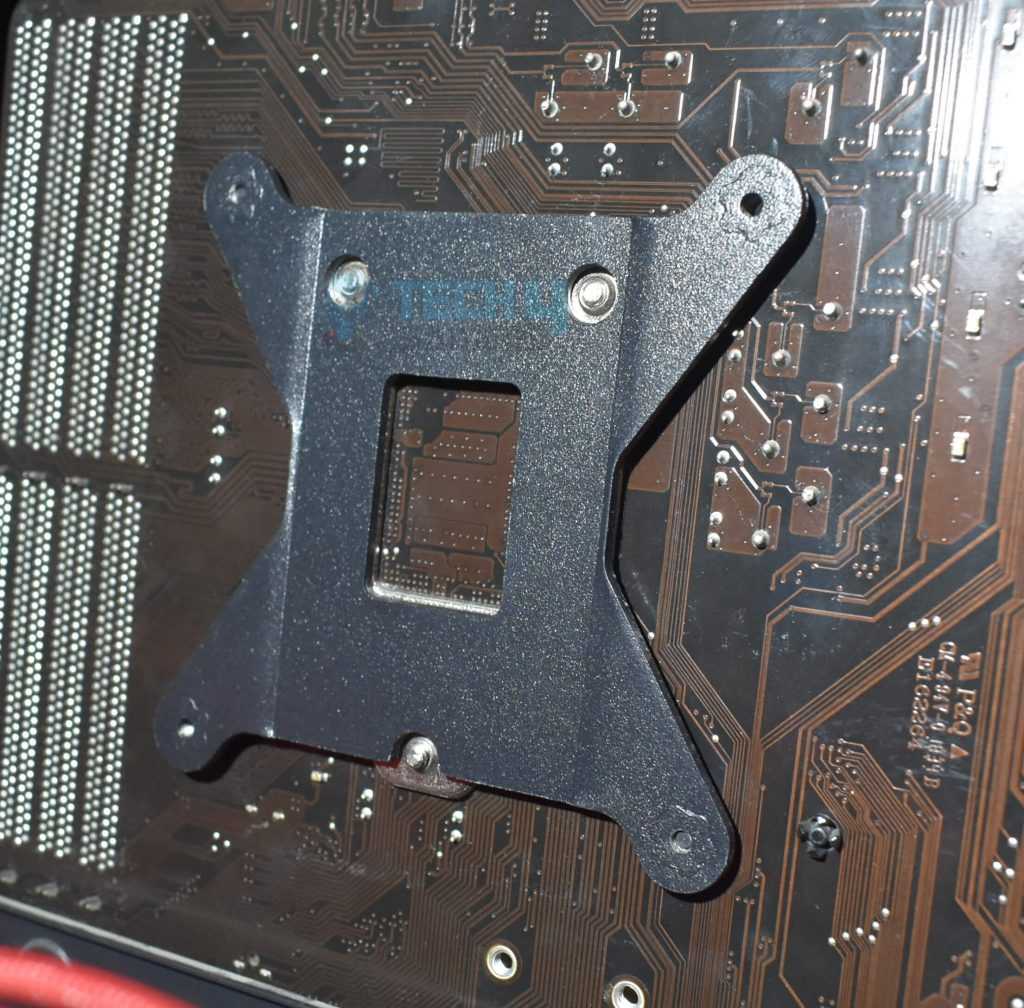
ARCTIC Liquid Freezer II 240 ARGB Installation
Now, using the Intel Socket 115x standoff, secure the backplate in place, making sure the connection is solid and firm.
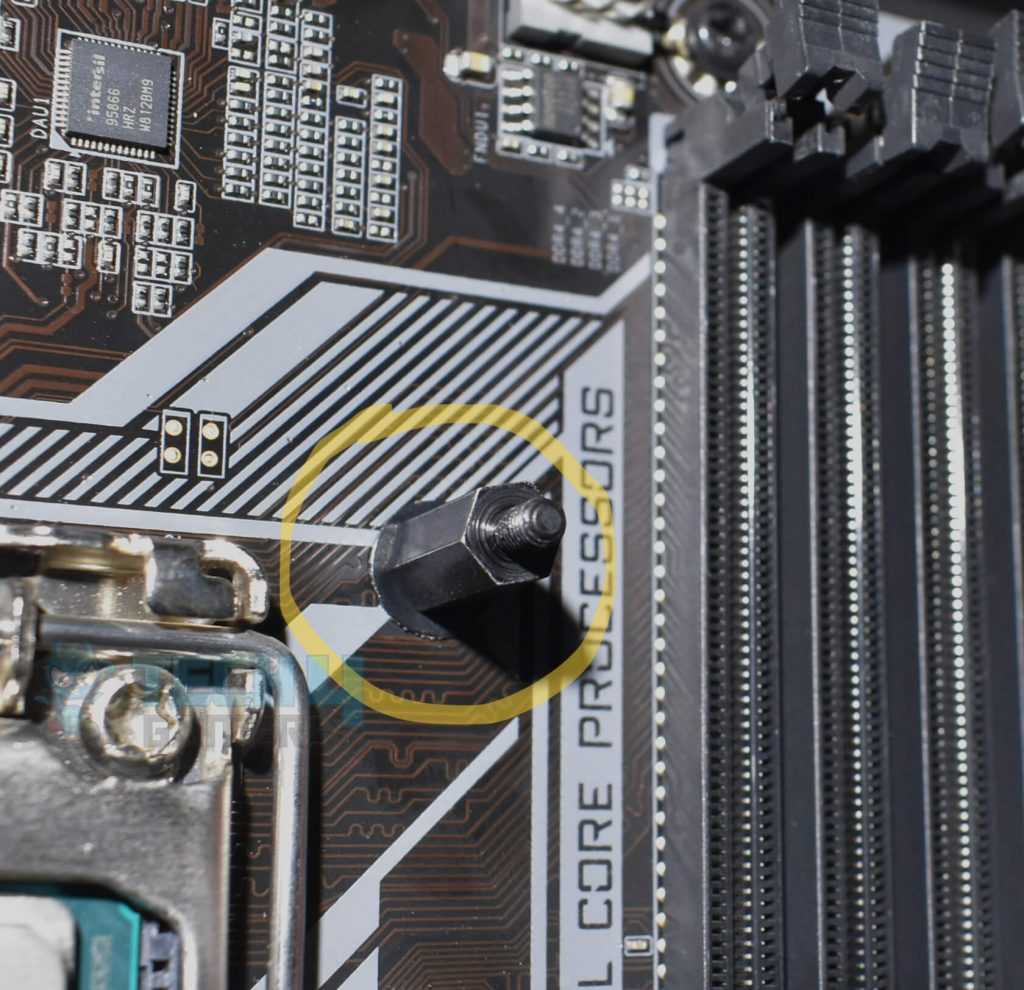
ARCTIC Liquid Freezer II 240 ARGB Installation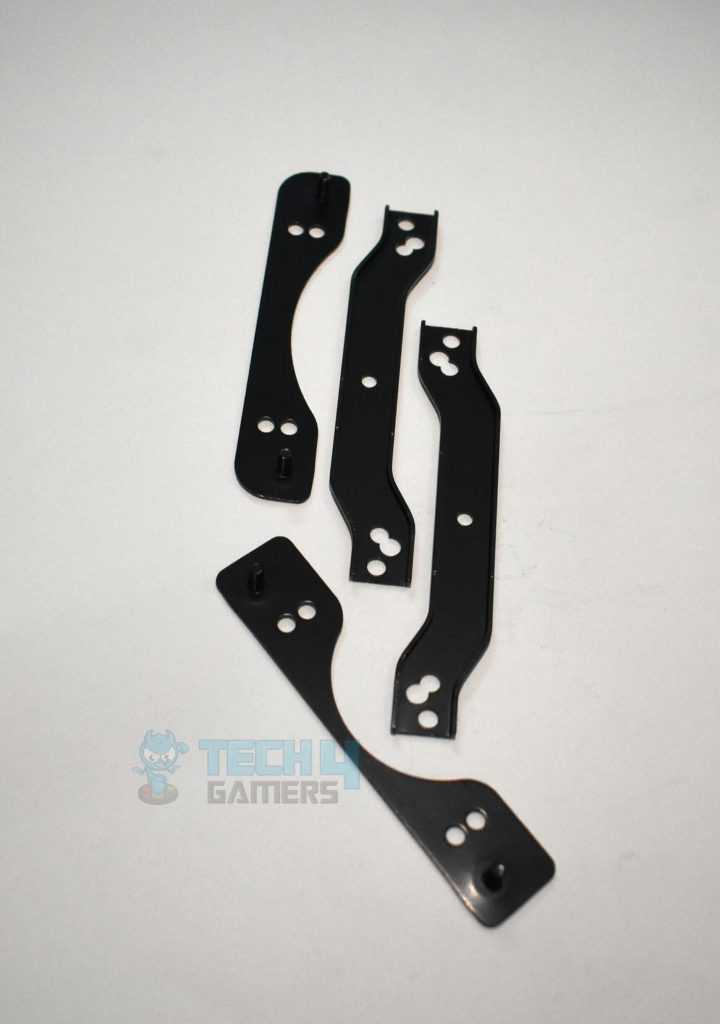
ARCTIC Liquid Freezer II 240 ARGB Installation
Select the right mounting bracket for your CPU socket and use the two included mounting screws to secure it to your pump header.
Ensure that both brackets are securely attached to the pump head and that the connection is upright.
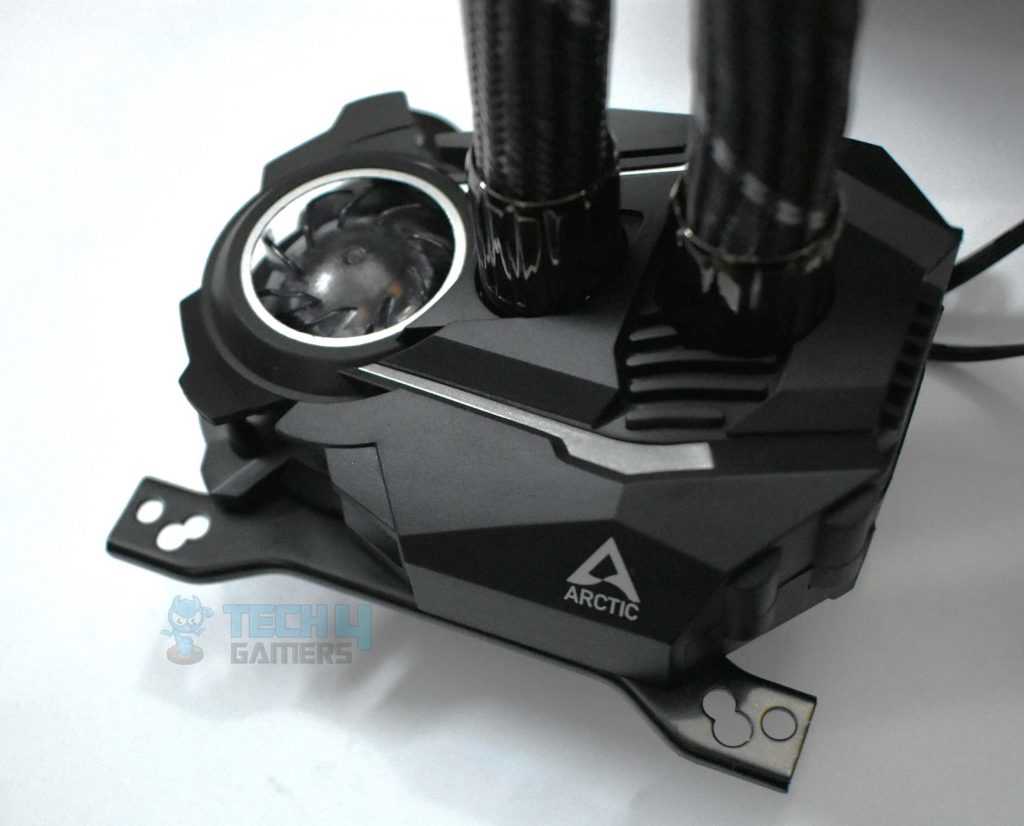
ARCTIC Liquid Freezer II 240 ARGB Installation
Apply some of the included MX-4 or MX-5 thermal paste to the top of your CPU. Remember to remove the plastic label from the copper base before attaching the pump head to your CPU.
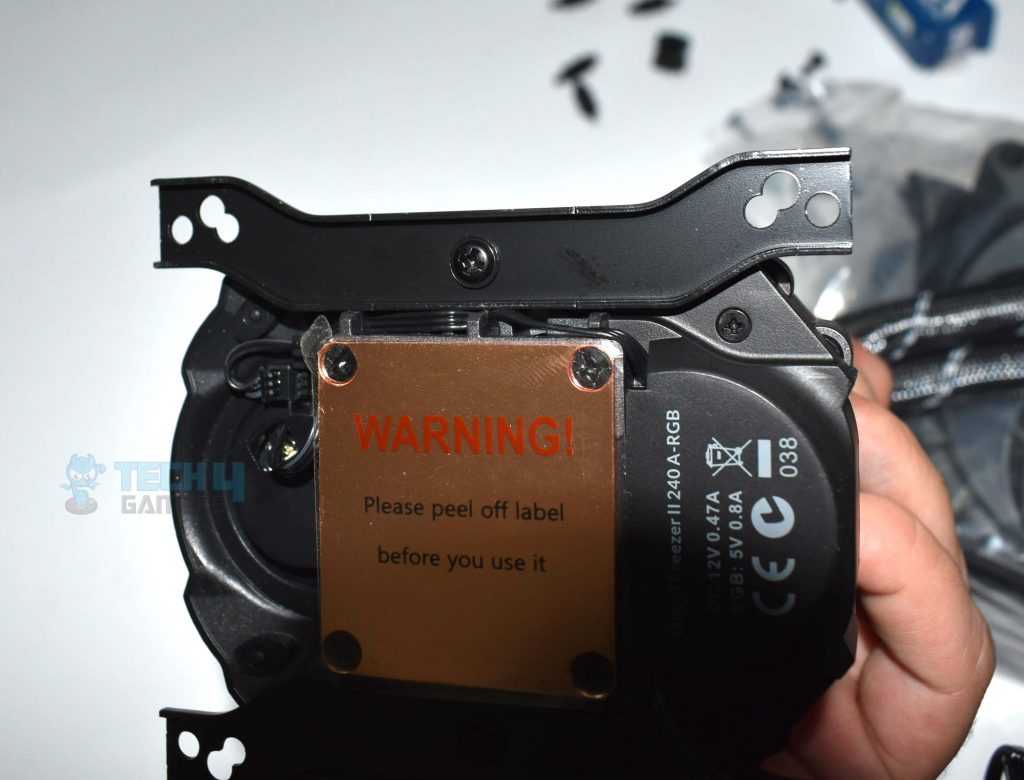
ARCTIC Liquid Freezer II 240 ARGB Installation
Use the thumb nuts to attach the pump head to your CPU after it’s in position.
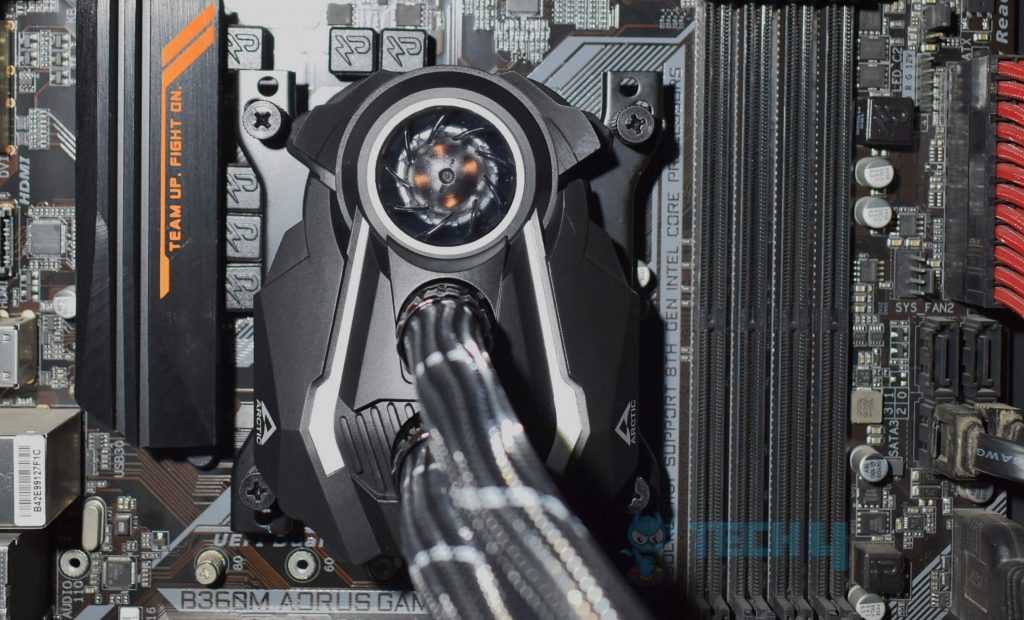
ARCTIC Liquid Freezer II 240 ARGB Installation
It’s time to connect the cables after everything is in its proper spot. Connect the 4-pin PWM connection to any available Fan header on your motherboard, then connect the 3-pin A-RGB header to an RGB header. Turn on your computer now that both connections are connected.
Performance
Testing the Arctic Liquid II I put it in my daily PC to see how it fared in a typical build since the features it offers should give it an edge over the traditional AIO designed coolers. I used my Ryzen 9 3900X on my ASUS ROG X370 Crosshair 6 Hero with the latest BIOS featuring AGESA 1.0.0.3 ABBA paired with 32GB of APACER NOX DDR4 3200 memory and stuffed it inside the NZXT H710i. The fan speed was let on the same stock curve pattern across all tests. I used the box Wraith Prism cooler to have stock representation and for the traditional AIO cooler, I used the Cooler Master ML240P since it’s actually one of the better AIOs of late.
| Component | Model |
|---|---|
| CPU | AMD Ryzen 9 3900X |
| Memory | APACER NOX 32GB (16GBx2) 3200MHz CL16 |
| PSU | Corsair AX860i |
| OS | Windows 10-64 Bit latest build |
| Motherboard | ASUS ROG X370 Crosshair 6 Hero (1.0.0.3 ABBA BIOS) |
| GPU | GeForce RTX 2080 FE |
| Case | NZXT H710i |
Installation
Most of the reviews that I’ve browsed over so far for the Arctic Liquid II are using an Intel socket, which is cool, but we wanted to see how this new cooler could handle the 12 core Ryzen 9 3900X. So far I’ve had much better luck with tower coolers like the Noctua NH-U12A rather than AIOs that I’ve tried regardless of brand. So we set out to see if this one could buck that trend. All installing really consisted of was mounting the fully assembled radiator/fan portion then mounting the universal CPU bracket in the correct orientation for AM4, then mounting it to the existing AM4 backplate with the proper length screws. Believe me, that sounds much easier than it actually is. The Intel socket mounts make use of the included backplate that is attached via standoffs and then secured using thumb nuts, and that is spectacular. But, the AM4 is much more cumbersome due to you having to hold the backplate in place, line up the pump/cold plate, and get the 4 screws to set in the backplate using a screwdriver all while the stiff tubing makes it want to shoot out of your hands. AMD owners may find themselves wanting for a second set of hands.
The other concern I had was when I noticed the size of the cold plate was pretty much the approximate size of the IHS for the Ryzen 9 3900X and that gave me pause for concern due to the nature of the chiplet design, but you’ll find in the performance section that those concerns were quickly put to rest.
Заключение
Система жидкостного охлаждения Arctic Cooling Liquid Freezer II 240 подкупает своим внешним видом и очень аккуратной компоновкой. На фоне 240-мм конкурентов она смотрится на голову выше именно по качеству исполнения и сборки. Скрытая укладка проводов очень сильно добавляет общей эстетике и без того лаконичного строгого дизайна. Даже несмотря на полное игнорирование модного тренда с ARGB-подсветкой, эта система охлаждения будет органично смотреться в современной сборке с прозрачными стенками или полуоткрытым типом корпуса. По результатам нашего тестирования эффективность охлаждения процессоров у Liquid Freezer II 240 хороша, но далека от заявленной планки с TDP до 300 Вт. Скорее её можно порекомендовать для процессоров, тепловой пакет которых не выходит за границы 200-220 Вт. Под эти значения попадает большинство процессоров desktop-сегмента с заделом на возможный разгон
Немаловажно, что во всех режимах работы шум комплектных вентиляторов и помпы остается на невысоком уровне, что в сегменте недорогих AIO-жидкостных контуров встречается реже, чем хотелось бы. В целом от знакомства с Arctic Cooling Liquid Freezer II 240 остались положительные впечатления
Благодаря хорошему соотношению эффективности и уровня шума, модель однозначно достойна приоритетного рассмотрения при подборе компонентов ПК от высокопроизводительного рабочего сегмента до домашних игровых сборок.
Преимущества Arctic Cooling Liquid Freezer II 240:
- Высокая эффективность;
- Радиатор увеличенной высоты (38 мм);
- Длинные армированные шланги (45 см);
- Тихие вентиляторы;
- Дополнительный 40-мм вентилятор на водоблоке для охлаждения околосокетного пространства;
- Очень аккуратная предварительная сборка со скрытой прокладкой кабелей вентиляторов;
- Термопаста Arctic Cooling MX-4 в комплекте;
Недостатки:
- Неповоротные фитинги на водоблоке;
- Дополнительный обдув VRM только в одном направлении;
- Не предусмотрено отдельное управление вентиляторами.


![Arctic liquid freezer ii 240 a-rgb review [2022] - tech4gamers](http://rozblog.ru/wp-content/uploads/4/d/1/4d1948c83f921cbdbec2e3e344d73c46.jpeg)















![Arctic liquid freezer ii 240 a-rgb review [2022] - tech4gamers](http://rozblog.ru/wp-content/uploads/5/5/0/5500ffe74b8edaa7cdc7af858dd069b3.jpeg)







![Arctic liquid freezer ii 240 a-rgb review [2022] - tech4gamers](http://rozblog.ru/wp-content/uploads/9/2/c/92c3e08117676871f653a774f897cd10.jpeg)